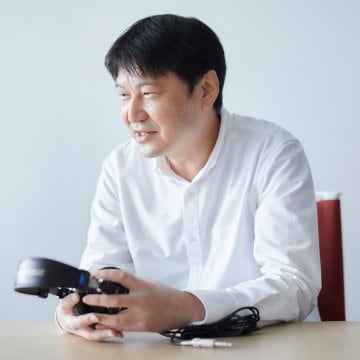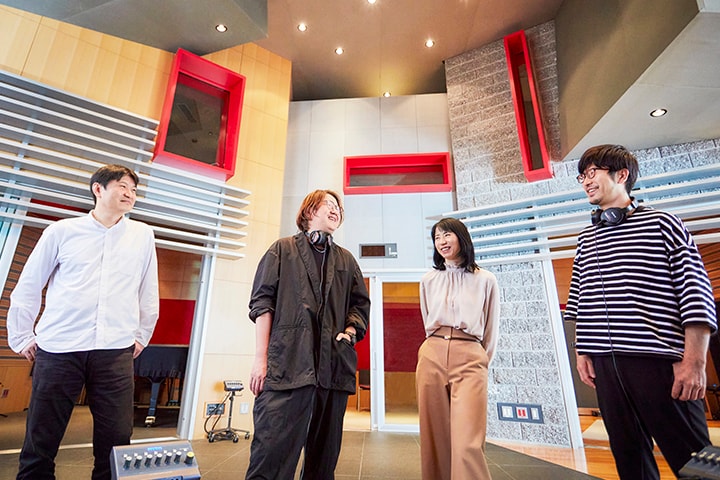BUSINESS
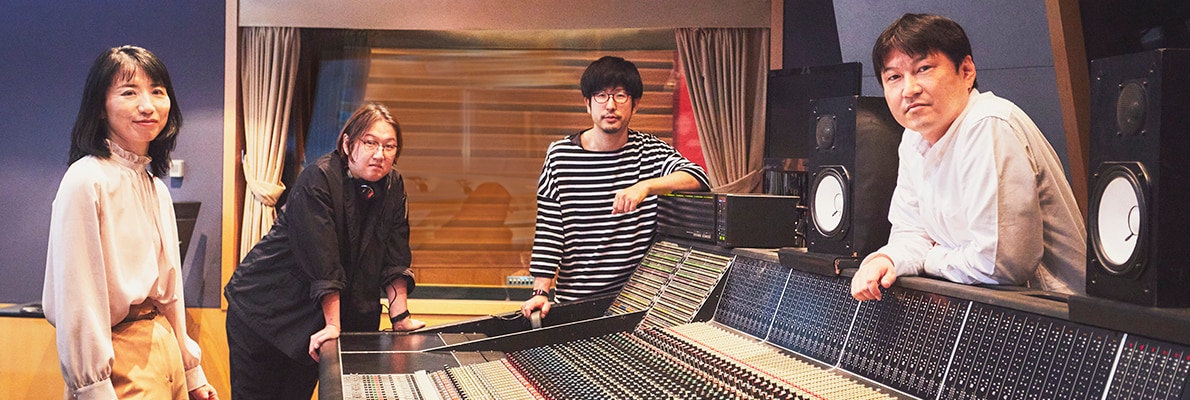

Mutual appreciation of the diverse expertise within the group helps create
the professional tools required for the times
MDR-M1ST headphones are the first professional monitor headphones Sony has launched in around 30 years in Japan market.
They are widely used by professional music creators in recording studios, as well as in recording and DTM production at home and in the studio.
We start with the history of the collaborative development work between the Electronics Products & Solutions business and the Music business,
which continued on from the MDR-M1ST model's predecessor, MDR-CD900ST professional monitor headphones. We then hear from project members about the power of diversity, equity and inclusion in the Sony Group, as applied to the new model.
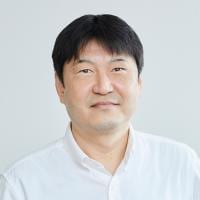 Hirofumi Nakayama
Hirofumi NakayamaSony Music Solutions Inc. Sony Music Studios Tokyo
 Shunsuke Shiomi
Shunsuke ShiomiSony Corporation MDR-M1ST Acoustic Designer
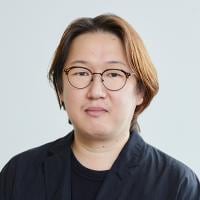 Motohiro Noguchi
Motohiro NoguchiSony Music Solutions Inc. Sony Music Studios Tokyo recording Engineer
 Noriko Mori
Noriko MoriSony Music Solutions Inc. MDR-M1ST Sales and Sales Promotion
Joint development work with studios began more than 30 years ago
Shiomi: Since around 2013, Sony's focus in the Japanese market in particular has been on popularizing Hi-Res*1, which allows users to enjoy high-quality music. Since no Hi-Res headphones were initially available for the recording studios where sound is created, however, we decided there was a need for compatible headphones and started development work as an independent research project among volunteers. Sony's MDR-CD900ST monitor headphones *2 were created more than 30 years ago and are still used by many professional music producers. Sony Music Studios Tokyo had collaborated on its development with us, so we took a prototype of the MDR-M1ST headphones there and joint development began after recording engineers carried out listening tests.
- *1Short for "high-resolution audio." Providing approximately 6.5 times the amount of information generated by a CD, digital audio is capable of reproducing details and nuances of sound that a CD cannot
- *2Headphones developed for monitoring sound in studios and other music production sites
Nakayama: MDR-CD900ST headphones were developed from MDR-CD900 consumer headphones, which were commercialized to handle the sound produced by CDs in the late 1980s, when the huge major shift from analog to digital music reproduction occurred. These headphones were originally designed for consumers, but Sony and CBS/Sony Studios (now Sony Music Studios Tokyo) undertook joint development work to see whether they could be used in music recording venues. At the time, Sony believed that hardware and software were two essential axes of the business, and I think this awareness in the work site led to collaboration among group companies. Engineers from Sony and the Studio were at the forefront of their respective fields in music production, and the success of the collaboration hinged on the fact that while they recognized each other as professionals, they were able to pursue the sound they aspired to individually without compromise.
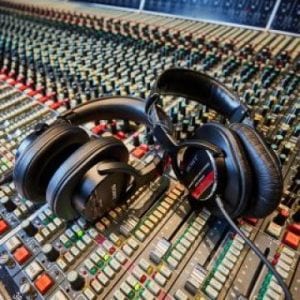
The challenge of developing new monitor headphones for the era of Hi-Res
Shiomi: The joint development process started with talk of making a Hi-Res version of MDR-CD900ST headphones. However, the way we make music has changed over the past 30 years with the spread of technologies like DTM*, and the use of sounds in bandwidths that could not previously be reproduced. We therefore decided to create monitor headphones that unlike MDR-CD900ST models are suited to the times we are in today. In developing these new headphones, we resolved not to release them to the world unless they were good. MDR-M1ST headphones might never have been launched without the company's broad-mindedness in allowing us to continue development until we were satisfied, no matter how many years it took.
- *DTM (short for Desk Top Music): A music production method that uses personal computers to create music
Noguchi: I joined the project halfway through because my boss, a recording engineer who was originally involved in the development of MDR-M1ST headphones, suggested that it would also be better to include younger engineers. I was interested in making new headphones and wanted to be involved.
Shiomi: Five studio engineers including Noguchi-san joined us in the project. As a designer, I was very grateful to have engineers of all ages participate in the project, taking on a variety of responsibilities including mastering and equipment maintenance. The process of designing while in direct communication with the studio engineers who would actually be using the equipment was both nerve-wracking and rewarding. As I had experience in designing flagship headphones for consumers in the past, I had my own standards for good sound. However, I set these aside and approached the project with a fresh mind, working to understand what constituted the good sound that studios required. The studio engineers welcomed my approach and responded sincerely. In the course of our exchanges, I came to realize that as an audio engineer the way I listen to sound differs from the way studio engineers focus on sound. The listening model for audio engineers like me is to strive to create a sound that gives the same sense of space and distance as that generated in a theater with an auditorium and a stage. In a studio, on the other hand, the need to hear the diverse expressions of music in greater detail means that we have to maintain the same sense of space as when listening, as well as the ability to express acoustic images at closer distances. Moreover, when reproducing sounds at higher volumes than normal, it is essential that the sounds of people's voices and melodic instruments that you particularly want to hear are not ear-piercing or distorted. We actually listened to the sound together to gain insights through experience. To be honest, we were subject to a lot of areas for improvement and things were difficult at times, but I was very happy to receive candid opinions.
Noguchi: We and Mr. Shiomi had different ideas about good sound. He is an engineer who makes headphones; we are engineers who make sound. To reconcile our differences, we used to continue our conversations after work. I found Shiomi easy to talk to because I was closer to him in age than other studio engineers, so we would go out to drink and chat together whenever he was troubled or down.
Shiomi: Our children are around the same age, we have similar lifestyles, and we share music as a hobby, so we talked about a lot of things other than work. Getting to know each other better enabled us to exchange opinions freely while respecting each other's views. Our conversations about work gradually became deeper and more intense.
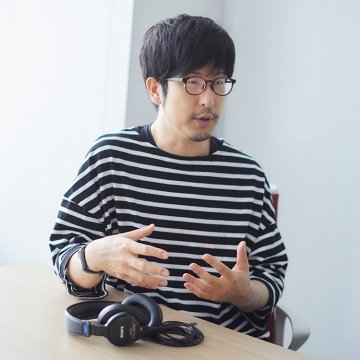
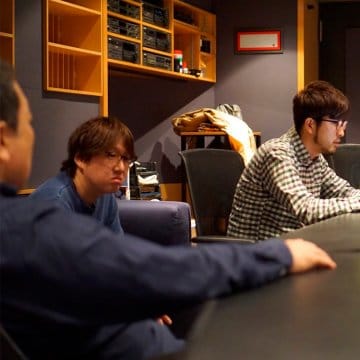 To gain an understanding of what studio engineers believe to be good sound, we held discussions while repeatedly listening to the same sounds.
To gain an understanding of what studio engineers believe to be good sound, we held discussions while repeatedly listening to the same sounds.Activities transcend boundaries to involve production and sales promotion work site
Shiomi: MDR-M1ST headphones are manufactured by Sony/Taiyo Corporation in Oita Prefecture, Japan. The person in charge of communications with us acoustic design engineers was a music lover who told us he was interested in how music is actually produced in a recording studio. When people at the Studio heard this, they invited him and his colleagues to visit from Oita, and we were able to arrange a studio tour for them. We also visited Sony/Taiyo with them because the studio engineers wanted to see how products are actually made. Sony/Taiyo is a special subsidiary of Sony Group Corporation where each headphone is carefully made manually by highly skilled craftsmen and women with a variety of unique skills. This plant is unique among Sony's many manufacturing facilities in that it takes a crafts like approach to manufacturing. Reaching greater mutual appreciation of the people, processes and attitudes involved in production greatly changed the way we subsequently approached our work.
Mori: Even some of the sales and promotion activities for MDR-M1ST headphones transcended the boundaries of normal business practices. While monitor headphones are a professional product, Sony Marketing, which sells consumer products, offered to exhibit them at consumer product events. This enabled us to appeal to music lovers and other people who are not professionals but are very fond of music. We have also started selling the product through Sony Stores as well as our existing sales channels. Thanks to the growing popularity of DTM among people working at home and personal streaming services such as YouTube, we are now able to deliver to an increasingly diverse customer base.
Designers from Sony Music Solutions, which is responsible for merchandising and other products, joined us in the MDR-M1ST product design process. As a result, we were able to reconcile the differing opinions of the product engineers, who wanted to ensure the traditions of the MDR-CD900ST brand were continued, and the studio engineers, who wanted to create something completely new. I am told the red line on the housing was designed to make the MDR-M1ST brand instantly recognizable. We are also particular about the photos we post on our website, enlisting our own studio engineers rather than models to appear in them to ensure greater realism in the scenes showing the product in actual use.
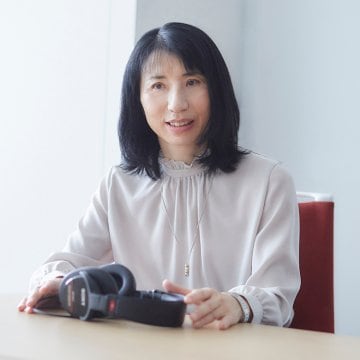
 Photos for the website. We used studio engineers instead of models to make things more realistic
Photos for the website. We used studio engineers instead of models to make things more realistic Towards new monitor headphones that meet a variety of needs
Noguchi: MDR-M1ST headphones have now been installed in our own studio, but initially it took me a while to make the actual transition from my familiar MDR-CD900ST headphones. Now that I am used to MDR-M1ST headphones, I find them very easy to use because I can envisage how the sound created using these headphones will sound through my speakers. They are comfortable to wear, so I don't get tired even if I use them for a long time. Musicians like them because the sound they deliver is better and much easier to listen to, while many appreciate that the detachable cable enables them to enjoy greater freedom of use. Some still like the slightly sharper feel of MDR-CD900ST headphones and the way the vocals come to the fore. People will select the model they use according to their needs since vocalists and guitarists, for example, look for different sounds. MDR-M1ST headphones are also suitable for listening, so you can use them for sound checks and MDR-CD900ST headphones for recording. It is really good to have two options.
Mori: Retailers in Japan have responded very enthusiastically to MDR-M1ST headphones. Following the press release, we received dozens of inquiries from retailers about inventories, delivery dates and images for sales promotion campaigns. One of our vendors told us that when they posted information about MDR-M1ST headphones on SNS for their customers, they received 20 times more "Likes" than usual. Additionally, when we lent demo units to several vendors before the launch, they all passionately posted photos of the product, the box it came it, detailed sound test reports and other information on SNS. I felt that everyone had been waiting for MDR-M1ST headphones for a long time.
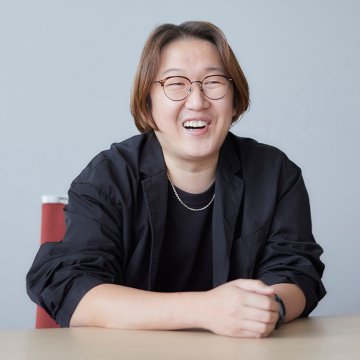
 MDR-M1ST headphones have received high praise from studio engineers and musicians for their excellent sound and ease of use
MDR-M1ST headphones have received high praise from studio engineers and musicians for their excellent sound and ease of use An important role of the studio is to provide a place to test technologies
Shiomi: Monitor headphones will continue to evolve in line with changes in the music production environment and technology, and the times. Since more and more people are telecommuting and can work anytime, anywhere as we adapt to COVID-19, ease of use in homes and other remote environments will also increase in importance. And while MDR-M1ST headphone compatibility with Hi-Res provided the impetus for their development, professional equipment will likely be developed to support the latest stereophonic technologies such as 360 Reality Audio going forward. Since music has "rescued" me personally in many ways, I am now making "giving back to music" the theme of my life. In my work, I want to continue serving as a bridge between music and customers through my involvement with the people who make the music.
Noguchi: Once, when I was telecommuting from home, I recorded my children's voices and played them back through headphones. They were startled to hear how their voices actually sounded to others. This is a small incident, but I hope that I can work and engage in workstyles in ways that expand such new experiences for children. I am very fortunate to work in delivering my creations to the world through music. As an engineer who creates sounds, I want to continue making good sounds, and being flexible in adapting and embracing new equipment. In my work as a recording engineer, I also hope to uncover hints that will lead to the development of new technologies and products.
Mori: I was also in charge of responding to media inquiries, in the process learning that this product was the result of four-year's trial and error and the passion of the people involved. From development through manufacturing to sales, they all worked toward the single objective of creating this product, and I am convinced my experience as one of them is invaluable. This project reminded me that horizontal connections transcending organizational boundaries are vital. The members I got to know here are people I can talk to immediately if I have a problem. I cherish this experience and will draw on it in future work.
Nakayama: As with MDR-M1ST earphones, providing a place where creators can verify how they actually use the technologies they are developing remains one of the Studio's roles within Sony. Having a studio with which we can work so closely is one of Sony's great strengths. Collaboration within the Sony Group has always been considered a given, not something special. I believe this will continue.
